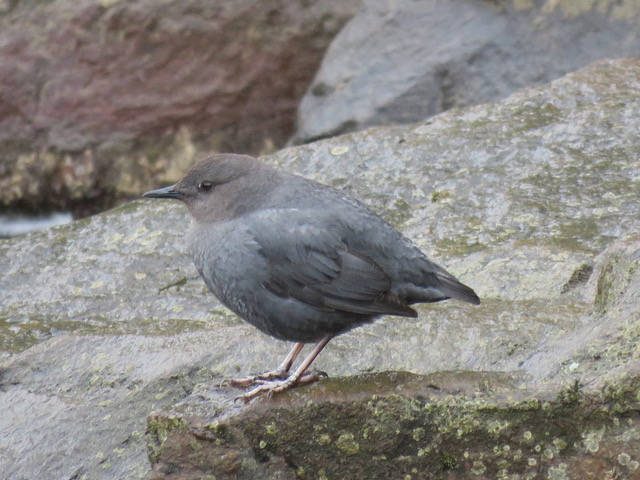The American Dipper, (Cinclus mexicanus) or “Water Ouzel,” as many affectionately call this hardy year-round resident of the Kenai Peninsula, can also be found as far south as Mexico. The ouzel (an Old English term) inhabits the mountains, so is rarely found east of the Rockies.
Naturalist John Muir described this charismatic bird, his favorite, as “… a singularly joyous and lovable little fellow, clad in a waterproof suit of bluish gray, with a tinge of chocolate on the head and shoulders. He is as smoothly plump and compact as a pebble that has been whirled in a pot-hole …”
As the name implies, the American Dipper dips. Theories about this iconic behavior include a communication device, an indication of disturbance, or spotting underwater prey. This characteristic dipping, or bobbling, makes the bird easy to identify. Another good field mark is the bright white feathers on its eyelids that cause the eyes to flash white when the dipper blinks.
This diminutive passerine (song bird), related to wrens and thrushes, has the distinction of being North America’s only aquatic songbird. One of five dipper species in the world, found only in North America, it is a master of flowing water — always residing along a rushing, boulder-strewn stream where it can forage underwater for aquatic insects, small fish, fish eggs, and, yeah, mosquito larvae. Though the dipper is adept at mid-air catches of insects, John Muir reminds us, “The Ouzel alone of all birds dares to enter a white torrent.” The Dena’ina of the Lime Village area in the Stony Mountains west of Cook Inlet call the dipper “tatsilqit’a,” which translates as “one who has its head in water.”
The American Dipper is an underwater marvel, capable of moving rocks while submerged. Without webbed feet, the dipper uses its long legs and strong toes to withstand whitewater currents, and is a master of using its wings underwater. It can navigate (fly) through the stream even in its preferred habitat of rapids, cascading streams, and waterfalls. The American Dipper is at home in chilling water, with a dense undercoat of down for insulation, and an oil gland 10 times larger than that of other Passerines. Preening, the dipper covers its feathers with oil for a water-repellent coat. Additional adaptations to its underwater habits are a moveable flap over the nostrils, an extra eyelid, and like a super athlete, blood cells with a large capacity for carrying oxygen, along with a very efficient thermoregulation system.
The female incubates the eggs for 13-17 days, then the male helps her feed the hungry chicks. The parents, by late summer, become reclusive as they molt all their wing and tail feathers, becoming flightless.
Preferred dipper nest sites are wet and within the shoreline — often a detriment if flooding occurs. The dipper selects cliff/shoreline ledges, or the crevice of a boulder, behind a waterfall or under a bridge. Nest material is often moss skillfully woven into a dome shape and located in mist which keeps the moss fresh and green.
Living always close to “torrents of water,” the American Dipper needs a loud song to be heard. Its song has been described as “bubbly.” Again the poetic voice of John Muir: “Nearly all of his music is sweet and tender, lapsing from his round breast like water over the smooth lip of a pool, then breaking farther on into a sparkling foam of melodious notes …”
What better outdoor adventure than to go dipper spotting in this bird’s majestic landscape settings — a white water stream, crashing over boulders, tumbling waterfalls, and mountain/canyon country. Want an easier adventure? Check around bridges for dipper nests.
Dippers are an indication of good water quality. Protecting streams from sedimentation, pollution, and toxic discharges will ensure the presence of aquatic insects, and thus dippers. As long as mountain streams flow free and clean, the song of this “joyous and lovable little fellow,” the Water Ouzel, will flow free and clear as well.
This article was adapted by Jack Wiles from “Discover the Dipper — California Academy of Sciences” written by Homer resident and birder Janet Klein while spending a summer at Four-Mile Canyon, Boulder, Colorado, studying the American Dipper or, her favorite, the Water Ouzel.
This article is brought to you by Kachemak Bay Birders. For more information about Kachemak Bay Birders birding trips, meetings, and other activities and events, go to kachemakbaybirders.org. Check out also the Bird of the Month, Citizen Science opportunities, Local Bird Information and much more. It’s a Great Day to Bird.


